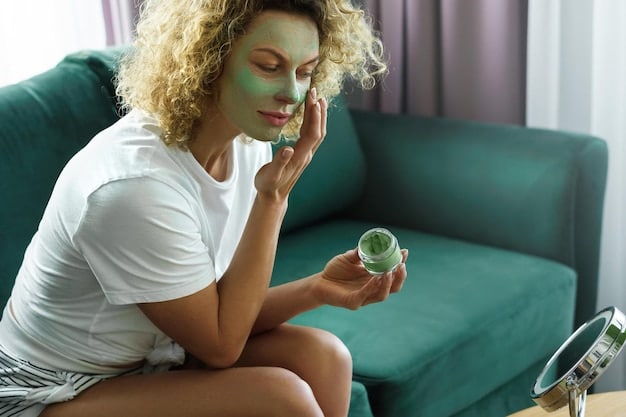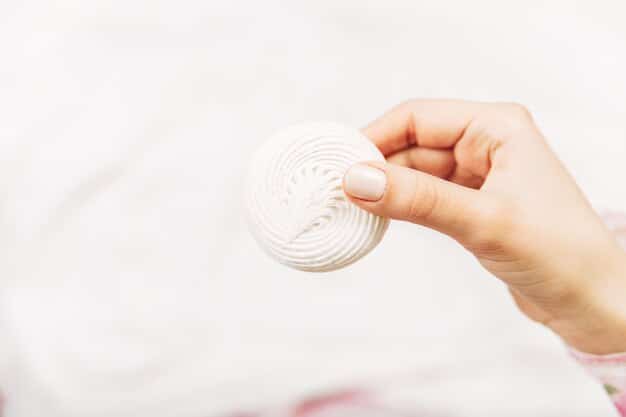The 5-Step Nighttime Skincare Routine for Visible Results

The 5-step nighttime skincare routine dermatologists recommend includes cleansing, toning, applying serum, moisturizing, and using retinol, which can deliver visible results within three months by promoting skin renewal and addressing specific concerns like fine lines and dark spots.
Ready to wake up with healthier, more radiant skin? Discover the 5-step nighttime skincare routine dermatologists recommend for visible results in 3 months, designed to rejuvenate your skin while you sleep.
Unlock Radiant Skin: The Power of a Nighttime Routine
A consistent nighttime skincare routine is crucial for achieving visible improvements in your skin’s health and appearance. While you sleep, your skin repairs itself, making it the perfect time to use products that promote cell turnover, hydration, and overall rejuvenation.
Dermatologists often emphasize the importance of a well-structured nighttime ritual. Not only can it accelerate positive changes, but it can also help prevent future damage. By incorporating the right products and techniques, you can transform your skin in just a few months.
Step 1: The Importance of Cleansing
The first and arguably most critical step in any nighttime skincare routine is cleansing. Throughout the day, your skin accumulates dirt, oil, makeup, and pollutants that can clog pores and lead to breakouts. Cleansing removes these impurities, allowing your skin to breathe and absorb subsequent products more effectively.
Choosing the right cleanser for your skin type is vital. Whether you have oily, dry, or sensitive skin, selecting a cleanser that addresses your specific needs can significantly improve the health and clarity of your complexion.
Types of Cleansers for Different Skin Types
- Oily Skin: Opt for a gel-based or foaming cleanser to remove excess oil and prevent clogged pores.
- Dry Skin: Choose a cream-based cleanser that provides hydration while gently cleansing the skin.
- Sensitive Skin: Look for fragrance-free, hypoallergenic cleansers that won’t irritate your skin.
- Combination Skin: A gentle, balanced cleanser that cleanses without stripping the skin of its natural oils is ideal.
Proper cleansing sets the stage for the rest of your skincare routine, ensuring that your skin is clean and ready to receive the benefits of other products. Skipping this step can hinder the effectiveness of your entire regimen.
Step 2: Toner – Balancing Your Skin
After cleansing, the next step is to use a toner. Toners are designed to balance the skin’s pH levels, remove any residual impurities, and prepare the skin for serums and moisturizers. They can also help to refine pores and improve the overall texture of your skin.
Choosing the right toner depends on your skin type and the specific concerns you want to address. Some toners are formulated to hydrate, while others target acne or reduce redness. Consider your individual needs when selecting a toner for your nighttime routine.

Benefits of Using a Toner
- Balances pH Levels: Toners restore the skin’s natural pH balance, which can be disrupted by cleansing.
- Removes Residual Impurities: Toners remove any lingering dirt or makeup that your cleanser may have missed.
- Prepares Skin for Serums and Moisturizers: Toners enhance the absorption of subsequent skincare products.
- Refines Pores: Some toners can help to minimize the appearance of pores.
Incorporating a toner into your nighttime skincare routine can significantly enhance the efficacy of your other products, leading to a healthier, more balanced complexion.
Step 3: The Power of Serums
Serums are potent skincare treatments packed with concentrated active ingredients. They are designed to target specific skin concerns, such as wrinkles, dark spots, and dehydration. Applying a serum at night allows these powerful ingredients to work while your skin regenerates.
There are numerous types of serums available, each formulated with different ingredients to address various skin issues. Selecting the right serum for your individual needs is essential for achieving the desired results.
Popular Serum Ingredients and Their Benefits
When selecting a serum, look for ingredients that target your specific skin concerns. Here are a few popular options:
- Hyaluronic Acid: Hydrates the skin and plumps fine lines.
- Vitamin C: Brightens the complexion and protects against free radical damage.
- Retinol: Promotes cell turnover and reduces the appearance of wrinkles.
- Niacinamide: Reduces redness, minimizes pores, and improves skin tone.
Serums are a valuable addition to any nighttime skincare routine, providing a concentrated dose of active ingredients that can dramatically improve the health and appearance of your skin.
Step 4: Moisturize for Hydration and Repair
Moisturizing is an essential step in any skincare routine, especially at night. While you sleep, your skin loses moisture, so applying a moisturizer helps to keep it hydrated and support the skin’s natural repair processes.
Choosing the right moisturizer depends on your skin type and the climate you live in. Those with dry skin may benefit from a richer, more emollient moisturizer, while those with oily skin may prefer a lighter, non-comedogenic formula.

Types of Moisturizers
There are several types of moisturizers available, each with different properties and benefits.
- Emollients: Help to soften and smooth the skin by filling in gaps between skin cells.
- Humectants: Attract moisture from the air and draw it into the skin.
- Occlusives: Create a barrier on the skin to prevent moisture loss.
Incorporating a moisturizer into your nighttime routine ensures that your skin stays hydrated throughout the night, promoting a healthier, more radiant complexion.
Step 5: Retinol – The Overnight Transformation
Retinol, a derivative of vitamin A, is a powerhouse ingredient in any anti-aging skincare routine. It works by promoting cell turnover, stimulating collagen production, and reducing the appearance of fine lines, wrinkles, and dark spots. Incorporating retinol into your nighttime routine can lead to significant improvements in your skin’s texture and tone.
Retinol can be potent, so it’s important to start with a low concentration and gradually increase it as your skin becomes acclimated. It’s also crucial to use retinol only at night, as it can make your skin more sensitive to the sun.
How to Incorporate Retinol
- Start Slow: Begin by using retinol once or twice a week to allow your skin to adjust.
- Apply at Night: Retinol can make your skin more sensitive to sunlight, so it’s best to use it at night.
- Use a Pea-Sized Amount: A small amount of retinol is sufficient to cover your entire face.
- Moisturize: Retinol can be drying, so follow up with a moisturizer to keep your skin hydrated.
By incorporating retinol into your nighttime routine, you can unlock its numerous benefits and achieve a more youthful, radiant complexion over time.
Following the 5-step nighttime skincare routine diligently will not only improve your skin’s visible appearance within three months but also establish a healthy foundation for long-term skin health and radiance.
| Key Point | Brief Description |
|---|---|
| 🧼 Cleansing | Removes dirt, oil, and makeup for clean skin. |
| ⚖️ Toning | Balances skin pH and prepares for serums. |
| ✨ Serums | Targets specific concerns like wrinkles and spots. |
| 💧 Moisturizing | Keeps skin hydrated and supports repair. |
FAQ
▼
Cleansing is often considered the most important step. Removing makeup, dirt, and oil allows your skin to repair itself overnight and prevents clogged pores.
▼
Exfoliating 1-2 times per week is generally recommended. Over-exfoliating can cause irritation, so listen to your skin and adjust accordingly.
▼
While some products can be used both morning and night, others are better suited for specific times. For example, it is best to use Retinol in the evening.
▼
It typically takes 4-12 weeks to see visible results. Consistency is key, so stick with your routine and be patient to see gradual improvements.
▼
If a product causes irritation, stop using it immediately. Consult a dermatologist if the irritation persists or worsens, as you might have an allergy.
Conclusion
Incorporating the 5-step nighttime skincare routine can significantly transform your skin’s health and appearance. By consistently cleansing, toning, applying serum, moisturizing, and using retinol, you can expect visible results within three months. Remember, it’s essential to choose products that suit your individual skin type and concerns to maximize the benefits of each step.





